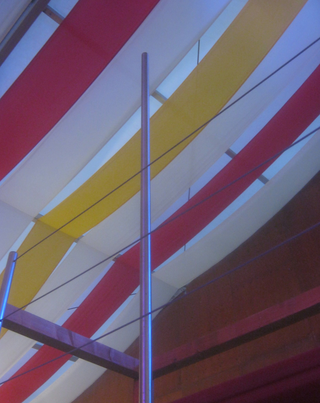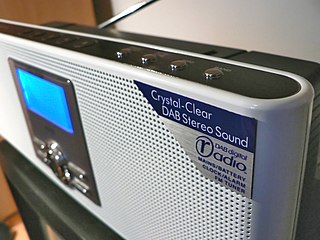Communications in the United States include extensive industries and distribution networks in print and telecommunication. The primary telecom regulator of communications in the United States is the Federal Communications Commission.
A television licence or broadcast receiving licence is a payment required in many countries for the reception of television broadcasts or the possession of a television set. In some countries, a licence is also required to own a radio or receive radio broadcasts. In such countries, some broadcasts are funded in full or in part by the licence fees. Licence fees are effectively a hypothecated tax to fund public broadcasting.

The Federal Communications Commission (FCC) is an independent agency of the United States federal government that regulates communications by radio, television, wire, satellite, and cable across the United States. The FCC maintains jurisdiction over the areas of broadband access, fair competition, radio frequency use, media responsibility, public safety, and homeland security.
In the United Kingdom, the term public service broadcasting (PSB) refers to broadcasting intended for public benefit rather than to serve purely commercial interests. The communications regulator Ofcom requires that certain television and radio broadcasters fulfil certain requirements as part of their license to broadcast. All of the television and radio stations have a public service remit, including those that broadcast digitally.
Public broadcasting involves AM and FM radio, shortwave radio, and television distribution by media outlets whose primary mission is public service. Public broadcasters receive funding from diverse sources including license fees, individual contributions, public financing and commercial financing. Many outlets stream their audio and video programs on the Internet, or produce content specifically for the web.
Regular television broadcasts in the United Kingdom started in 1936 as a public service which was free of advertising, which followed the first demonstration of a transmitted moving image in 1926. Currently, the United Kingdom has a collection of free-to-air, free-to-view and subscription services over a variety of distribution media, through which there are over 480 channels for consumers as well as on-demand content. There are six main channel owners who are responsible for most material viewed.

Low-power broadcasting is broadcasting by a broadcast station at a low transmitter power output to a smaller service area than "full power" stations within the same region. It is often distinguished from "micropower broadcasting" and broadcast translators. LPAM, LPFM and LPTV are in various levels of use across the world, varying widely based on the laws and their enforcement.
A non-commercial educational station is a radio station or television station that does not accept on-air advertisements, as defined in the United States by the Federal Communications Commission (FCC) and was originally intended to offer educational programming as part, or whole, of its programming. NCE stations do not pay broadcast license fees for their non-profit uses of the radio spectrum. Stations which are almost always operated as NCE include public broadcasting, community radio, and college radio, as well as many religious broadcasting stations. Nearly all Non-Commercial radio stations derive their support from listener support, grants and endowments, such as the governmental entity Corporation for Public Broadcasting (CPB) that distributes supporting funds provided by the congress to support Public Radio.

The Office of Communications, commonly known as Ofcom, is the government-approved regulatory and competition authority for the broadcasting, telecommunications and postal industries of the United Kingdom.
Public-access television is traditionally a form of non-commercial mass media where the general public can create content television programming which is narrowcast through cable television specialty channels. Public-access television was created in the United States between 1969 and 1971 by the Federal Communications Commission (FCC), under Chairman Dean Burch, based on pioneering work and advocacy of George Stoney, Red Burns, and Sidney Dean.
A broadcast license is a type of spectrum license granting the licensee permission to use a portion of the radio frequency spectrum in a given geographical area for broadcasting purposes. The licenses generally include restrictions, which vary from band to band.

The Public Broadcasting Act of 1967 issued the congressional corporate charter for the Corporation for Public Broadcasting (CPB), a private nonprofit corporation funded by taxpayers to disburse grants to public broadcasters in the United States, and eventually established the Public Broadcasting Service (PBS) and National Public Radio (NPR). The act was supported by many prominent Americans, including Fred Rogers, NPR founder and creator of All Things Considered Robert Conley, and Senator John O. Pastore of Rhode Island, then chairman of the Senate Subcommittee on Communications, during House and United States Senate hearings in 1967.

Broadcast law and Electricity law is the field of law that pertains to broadcasting. These laws and regulations pertain to radio stations and TV stations, and are also considered to include closely related services like cable TV and cable radio, as well as satellite TV and satellite radio. Likewise, it also extends to broadcast networks.
Cable television first became available in the United States in 1948. By 1989, 53 million U.S. households received cable television subscriptions, with 60 percent of all U.S. households doing so in 1992. Most cable viewers in the U.S. reside in the suburbs and tend to be middle class; cable television is less common in low income, urban, and rural areas.
Retransmission consent is a provision of the 1992 United States Cable Television Consumer Protection and Competition Act that requires cable operators and other multichannel video programming distributors (MVPDs) to obtain permission from commercial broadcasters before carrying their programming.

An underwriting spot, known as sponsor credit in Japan, is an announcement made on public broadcasting outlets, especially in the United States, in exchange for funding. These spots usually mention the name of the sponsor, and can resemble traditional television advertisements in commercial broadcasting to a limited extent; however, under the terms of a public broadcaster's license from the Federal Communications Commission, such spots are prohibited from being promotional or making any sort of "call to action". In the U.S., these restrictions apply to any television or radio station licensed as a non-commercial educational (NCE) stations, and even for non-sponsoring companies and products. However, this is not the case in Japan, as these spots can be played on both public and private broadcasters and are typically played alongside traditional commercials and appear after a show's opening theme or after a preview of a next episode or appear during a scene of a show.

A personal FM transmitter is a low-power FM radio transmitter that broadcasts a signal from a portable audio device to a standard FM radio. Most of these transmitters plug into the device's headphone jack and then broadcast the signal over an FM broadcast band frequency, so that it can be picked up by any nearby radio. This allows portable audio devices to make use of the louder or better sound quality of a home audio system or car stereo without requiring a wired connection. They are often used in cars but may also be in fixed locations such as broadcasting from a computer sound card throughout a building.

In the United Kingdom, the roll-out of digital radio has been proceeding since engineering test transmissions were started by the BBC in 1990 followed by a public launch in September 1995. The UK currently has one of the world's biggest digital radio networks, with about 500 transmitters, three national DAB ensembles, one regional DAB ensemble, 48 local DAB ensembles and an increasing number of small-scale DAB ensembles broadcasting over 250 commercial and 34 BBC radio stations across the UK. In London there are already more than 100 different digital stations available. In addition to DAB and DAB+, radio stations are also broadcast on digital television platform as well as internet radio in the UK. Digital radio ensemble operators and stations need a broadcasting licence from the UK's media regulator Ofcom to broadcast.
In the United Kingdom, community radio refers to a system of licensing small, micro-local, non-profit radio stations, which started in 2002. In its early days, the pilot scheme was known as access radio. New legislation paved the way for this additional tier of radio, starting in 2005, and hundreds of community stations have since been set up. Unlike commercial radio licensing, which is generally advertised to cover a specific region, community radio stations are usually limited to broadcast areas smaller than commercial or BBC local stations, nominally within a 5 kilometres (3.1 mi) radius of their transmitter.
An Internet radio license is a specific type of broadcast license that allows the licensee to operate an Internet radio station. The licensing authority and number of licenses required varies from country to country, with some countries requiring multiple to cover various areas of a station's operation, and other countries not having stringent licensing procedures in place. Licensing costs also vary, based on the number of listeners that a station has, as well as other factors such as the number of songs played, the number of broadcast hours, and whether tracks are dubbed to a digital playout system.







